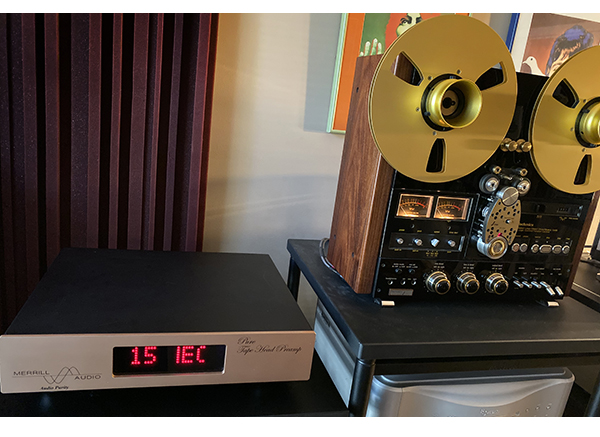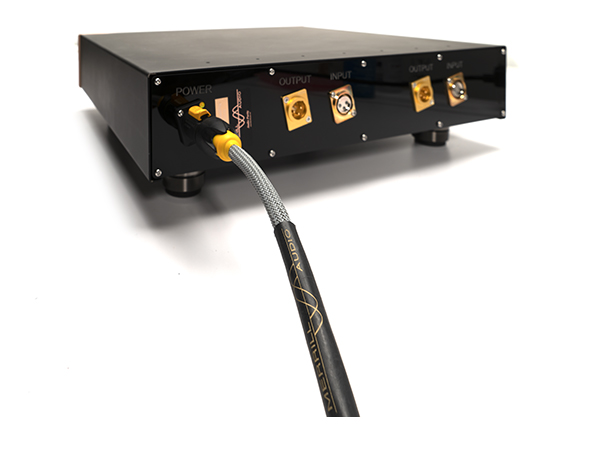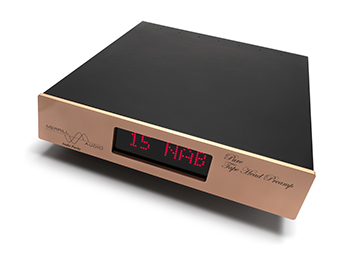The Merrill Audio PURE Tape Head Preamp Pure Performance
By Tom Caselli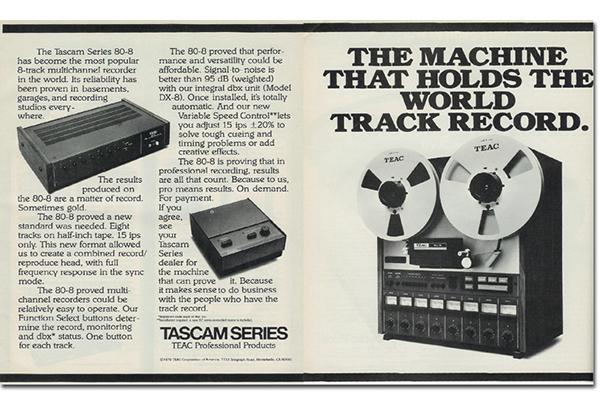 If you grew up in the hifi era of the 60s and 70s, magazines featured the latest stereo equipment in their ads and editorial pages, and the reel to reel tape deck was the pinnacle. You may have owned one, yourself.
If you grew up in the hifi era of the 60s and 70s, magazines featured the latest stereo equipment in their ads and editorial pages, and the reel to reel tape deck was the pinnacle. You may have owned one, yourself.
Most were bought to record radio broadcasts or to record music to have continuous play of music for several hours – a long playing tape at 3 ¾ i.p.s. was the original party playlist. The convenience of the compact cassette began the end of open reel tape and the introduction of the compact disc accelerated the decline. The advent of home digital recording in the nineties finished the market for reel to reel decks.
Yet over the last five years or so, reel to reel has been making a quiet comeback. If you’ve attended any audio shows recently, you’ve probably noticed open reel tape decks playing in more and more rooms. Approximately, ten years ago a company arrived on the audio horizon that offered the ultimate in-home music playback, copies of original master tapes. The Tape Project was a brave endeavor, licensing master tapes, with 1:1 copies available to the few. Squarely aimed at the well-heeled audiophile, priced at $450 per album it was a labor of love. Several other startup’s followed suit along with some of the established names such as Analogue Productions and Groove Note.
These new, professional grade tapes bore no resemblance to the pre-recorded reel tapes from earlier days, mass duplicated on 7 ½-inch reels. Most of today’s open reel tapes are produced on 10 ½-inch reels, in 15i.p.s., half-track configuration. Perhaps the biggest difference of all is todays tapes using IEC equalization instead of the NAB EQ used in past consumer tapes. Today’s tapes are a studio effort from start to finish.
Fast forward to 2019
Since the manufacture of new reel to reel decks is non-existent, a cottage industry has developed, supporting the renewed interest in the reel format. In addition to several companies doing ground up restoration of vintage decks, a new tape manufacture came aboard to offer tape stock along with the revitalization of the last original tape manufacturer.
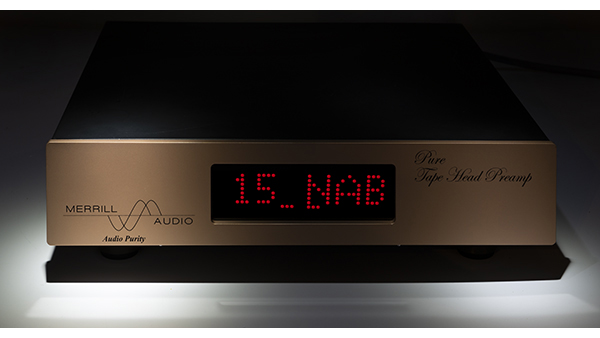 This brings us to the point of this review, a tape head preamp. If you are new to the format, you may wonder why you need an external tape head preamp, because tape decks all came with line level outputs. Like a phono cartridge, the tape head is a low output device that requires boosting and equalization to be used as a line level source.
This brings us to the point of this review, a tape head preamp. If you are new to the format, you may wonder why you need an external tape head preamp, because tape decks all came with line level outputs. Like a phono cartridge, the tape head is a low output device that requires boosting and equalization to be used as a line level source.
In the heyday of hifi, it would have been unthinkable that a preamp, receiver or integrated amp would not have a built-in phono stage. However just as we have discovered over the last couple of decades with the onslaught of phono preamps, a dedicated well-designed phono preamplifier reveals more music in the playback of vinyl. The same applies to tape playback: simply put most of the built-in circuitry while acceptable can be improved upon. To take full advantage of what todays tapes have to offer, it’s a necessity.
Unlike your turntable, you cannot simply insert the Tape preamp between the deck and your preamp. All decks regardless if they are consumer, prosumer or even professional require some modification to use an external tape preamplifier. Without going into specifics, you need to be able to take the signal directly from the playback head. The good news is that if you are not technically inclined most skilled technicians can do this for you at a reasonable cost.
Merrill Audio, based in New Jersey has joined a small but growing number of companies offering tape preamps and the first to offer a non-tube unit. I chose to use the term non-tube instead of the dreaded term solid-state because many think of solid-state as having a cold sterile harsh sound, which todays best solid-state gear simply does not.
Much like a great phono stage, external tape head preamplifiers are similarly priced. The Merrill PURE has an MSRP of $9,000. Not inexpensive, but by no means crazy money, especially when put in the context of what a phono preamplifier of similar performance would cost.
The PURE is the first of three units that Merrill will be offering, with additional flexibility as you move up the chain. The PURE features an outboard power supply connected by an umbilical cable, sufficient in length, to allow placement of it away from the electronics. The preamp itself offers well machined casework with a large display that can be easily read from across the room. Although, given its pro audio roots, input and output connections are balanced XLR only.
During the review period, it was used in both balanced and SE mode, using Cardas XLR/RCA adapters with no degradation in sound. Two toggle switches hidden on the bottom of the chassis allow gain selection (65db and 71db) and tape equalization for numerous speeds. The PURE Tape Preamp comes with predefined Equalization settings for 3 ¾, 7 ½, 15 for both NAB and IEC as well as a 30 IEC2/AES setting.
Diving in
With the general audience for external tape preamplifiers being pro studios and very serious tape users, there is a lot of demand for the 15 i.p.s. setting, but this isn’t the only path. A number of internet pundits devoted to open reel playback have a general disdain for pre-recorded, ¼ track tapes, which run at 7 ½ i.p.s. and 3 ¾ i.p.s.. With a large collection at my disposal, I feel that overlooking this segment of recorded music is a mistake. Though many rock titles were produced using a high speed duplication process (resulting in somewhat inferior playback quality) many of the early Jazz and Classical title offer sound that surpasses their vinyl counterparts.
The key to enjoying these tapes to the fullest is the ability to select the proper EQ for the tape you are playing – there is no one size fits all here. Other premium tape head preamplifiers I’ve used need to be recalibrated when changing tape speeds, or offer no predefined tape speed EQ at all. Fortunately, the PURE eliminates this problem, making it easy to switch EQ.
Background prep
Before sending our review unit, Merrill Audio asked if I required input cards for the ATR 102, a professional deck currently available from ATR Services. This leads me to believe that the Pure Tape Head preamp was targeted at those users. While I’m not an ATR owner I do have the following decks as reference components: JCorder with an external head block housing Flux Magnetics half and quarter track heads, a customized Revox PR99 that was built with direct head output as well as custom playback electronics by Soren Wittrup of CS Electronics and an Otari MX5050 with Flux Magnetics half track heads and direct output. My Studer A807 is currently out for service.
I tried to source a wide range of music and variations on the format to put the PURE through its paces. The following tapes were used for evaluation: AP’s Muddy Waters The Folk Singer, Fritz Reiner’s amazing version of Prokofiev’s Lieutenant Kije, The Tape Projects’ Jerry Garcia/David Grisman, and Sonny Rollins’ Saxophone Colossus – all are produced at 15i.p.s. using IEC EQ. Commercial 7 ½ i.p.s.quarter track versions of John Coltrane’s Giant Steps and A Love Supreme along with Charles Mingus’ Mingus, Mingus, Mingus and Blues and Roots were used for comparison.
The sheer quiet of the PURE is apparent before you even push the play button.
Before the tape starts, background noise seems to be reduced. When the music starts, the PURE’s ultra low noise floor allows subtle details in the recordings to shine, much like a premium phono preamplifier offers a deeper and blacker background, it’s the same with tape. Merrill’s electronics are known for lightening fast transient response, and the PURE upholds that tradition. Garcia’s guitar work on the Garcia/Grisman tape has the ring associated with well recorded acoustic guitar. The opening rim shots on Sonny Rollins’ “St. Thomas” are equally lifelike and full of excitement.
The soundstage rendered expands far beyond my speaker boundaries and depth has the illusion of extending beyond the rear wall. This is true analog involvement. The Lieutenant Kije tape gives a panoramic view of the orchestra, and the dynamic swings have no drag in timing. Finesse is not a word I usually associate with Muddy Waters however it is the word that comes to mind listening to the tape. It’s easy to hear and feel Waters’ breathe and bellow at the beginning of “Mr Captain” in a way that you just can’t realize without the additional resolution an external tape head preamplifier provides.
Bonus points
The PURE’s ability to play 7 ½ i.p.s. ¼ track tapes without recalibration is its crowning achievement for tape enthusiasts with a diverse tape collection. While the current crop of 15ips tapes use new high output tape, vintage commercial tapes were recorded at lower levels, to avoid saturating the tape formulations of the day. Switching the output of the preamp to the higher setting. selecting the 7 ½ NAB setting allows these tapes to shine like never before. While they will never challenge the performance of the current premium crop of master copies, they can outperform their best vinyl counterparts, as I hinted at earlier.
Those with tape collections that include these pre-recorded vintage tapes can now take full advantage of what these tapes have to offer. An informal gathering of audiophile friends left my place shocked at just how much information is lurking in these tapes. The vintage version of Coltrane’s A Love Supreme eclipses even my best vinyl pressings on hand. From the opening soprano sax cry in “Acknowledgement” through the opening bass line of “Resolution” it feels as if you are being moved closer to the control room than in any other version available.
The PURE offers a level of refinement, with a smooth extended top end, but the overall bass performance is really this unit’s calling card. Without exception, bass takes on a new dimension on every recording thrown at it.
Final thoughts/fine points
In auditioning the three decks on hand, the decks with Flux Magnetic heads reap the biggest gains in performance. Adding the external preamp allows your tape deck to become a fully realized audiophile component. The Revox Pr99 which has the stock Studer/Revox heads received the least bit of enhancement, more in terms of a lower noise floor and resulting dynamic range.
My only qualm with the unit is a remote that performs less than perfectly. Often, using a remote for another unit in my system it would cause the Pure preamp to change speed selection. Fortunately, the PURE rarely needs the remote; most will set it and only change the selection when a different format of tape is used. This is easily accomplished with a flip of the switch on the front panel.
Like all other Merrill components, the front panel has a very large display showing the tape speed and Eq currently being used. I understand how in a studio environment this is useful from across a darkened control room, however in a domestic environment it’s obtrusive, thankfully it can be turned off.
If you are a serious tape head and have suitable tape transports, I strongly urge you to audition the Merrill PURE. It is a worthy addition to your tape playback chain.
The Merrill PURE Tape Head Preamplifier
MSRP: $9,000
www.merrillaudio.net/tape-head-preamplifier
PERIPHERALS
Preamplifier Pass Labs XP-32
Power Amplifier Pass Labs XA100.8 monoblocks
Speakers Wilson Audio Alexia 2
Cable Kimber Select



